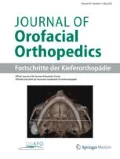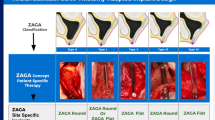Abstract
Objective
Rapid maxillary expansion (RME) is usually used for expanding the maxillary bony segments. Many studies have assessed the dental and skeletal effects of the expansion treatment but few studies evaluated soft tissue changes using cone beam computed tomography (CBCT) images. This study aims to compare soft tissue changes after RME in prepubertal and postpubertal subjects using CBCT images. The null hypothesis of this study is there is no difference between prepubertal and postpubertal patients in soft tissue changes after RME treatment.
Materials and methods
A total of 28 patients (10 males, 18 females) with a bonded type of rapid maxillary expander were included in this study. The patients were divided into two subgroups according to cervical vertebral maturation stage. Prepubertal and postpubertal groups were obtained. Following the selection of CBCT images from the archive, pretreatment (T0) and postretention measurements (T1) were performed. Nine linear and one angular measurement for a total of 10 measurements were evaluated on each CBCT image. The mean differences between T0 and T1 measurements were compared by using the paired-samples t test and significance was set at P < 0.05.
Results
The largest median increase was found in cheek projection of the prepubertal group. Changes in soft tissue nasal base, philtrum width, upper lip length, columella width, columella height, and cheek projection were statistically significant (P < 0.001) in both groups. No significant differences were observed in soft tissue alar base, nostril width, nostril height, and nasolabial angle.
Conclusion
Some significant changes in facial soft tissues were observed after RME treatment but there were no significant differences between prepubertal and postpubertal subjects. The null hypothesis is accepted because there were no significant differences between the groups.
Zusammenfassung
Ziel
Die forcierte Gaumennahterweiterung (GNE; “rapid maxillary expansion”, RME) wird in der Regel eingesetzt, um knöcherne Anteile der Maxilla zu verändern. Zahlreiche Studien haben sich mit den dentalen und skelettalen Effekten einer Expansionsbehandlung ausgeinandergesetzt, aber nur in wenigen wurden auch die Weichgewebeveränderungen mittels digitaler Volumentomographie (DVT; “cone beam computed tomography”, CBCT) bildgebend untersucht. In der vorgestellten Untersuchung sollten mögliche durch die forcierte Gaumennahterweiterung induzierte Weichteilveränderungen bei präpuberalen und postpubertären Probanden anhand von DVT-Aufnahmem ermittelt werden. Die Nullhypothese war, dass zwischen beiden Gruppen kein Unterschied hinsichtlich Weichteilveränderungen nach RME-Behandlung besteht.
Material und Methoden
Insgesamt 28 Patienten (10 Männer, 18 Frauen) mit einer direkt geklebten GNE-Apparatur wurden in die Studie aufgenommen. Je nach CVM (“cervical vertebral maturation”)-Stadium wurden sie in 2 Untergruppen eingeteilt, sodass sich präpuberale und postpubertäre Gruppen ergaben. An den aus dem Archiv ausgewählten DVT-Aufnahmen wurden Messungen vor (T0) und nach (T1) Behandlung vorgenommen: auf jeder DVT-Aufnahme wurden 9 lineare Messungen und eine Winkelbestimmung evaluiert. Die Mittelwerte der Unterschiede zwischen den T0- und T1-Messungen wurden mit dem t Test für gepaarte Stichproben verglichen, das Signifikanzniveau wurde bei p < 0,05 festgelegt.
Ergebnisse
Die im Mittel deutlichste Vergrößerung bestand bei der Wangenprojektion in der Gruppe präpuberaler Patienten. In beiden Gruppen waren statistisch signifikante Veränderungen (p < 0,001) zu beobachten bei den Parametern Nasenbasis, Philtrumbreite, Oberlippenlänge, Breite und Höhe der Columella nasi sowie “cheek projection”. Bei den Parametern Flügelbasis (Weichgewebe), Nasenlochweite und -höhe sowie nasolabialer Winkel waren keine signifikanten Unterschiede zu beobachten.
Schlussfolgerungen
Nach RME-Behandlung ließen sich Veränderungen in fazialen Weichgeweben beobachten, es bestanden jedoch keine statistisch signifikanten Unterschiede zwischen präpuberalen und postpubertären Patienten. Die fehlenden statistisch signifikanten Unterschiede zwischen den beiden Gruppen bestätigten die Nullhypothese.





Similar content being viewed by others
References
Adkins MD, Nanda RS, Currier GF (1990) Arch perimeter changes on rapid palatal expansion. Am J Orthod Dentofac Orthop 97:194–199
Aldren C, Tolley NSV (1991) Further studies on nasal sensation of airflow. Rhinology 29:49–55
Altorkat Y, Khambay BS, McDonald JP, Cross DL, Brocklebank LM, Ju XV (2016) Immediate effects of rapid maxillary expansion on the naso-maxillary facial soft tissue using 3D stereophotogrammetry. Surgeon 14(2):63–68. doi:10.1016/j.surge.2014.04.005 (Epub 2014 Jun 16)
Baccetti T, Franchi L, McNamara JA Jr (2005) The cervical vertebral maturation (CVM) method for assessment of optimal treatment timing in dentofacial orthopedics. Semin Orthod 11:119–129
Berger JL, Pangrazio-Kulbersh V, Borgula T, Kaczynski R (1998) Stability of orthopedic and surgically assisted rapid palatal expansion over time. Am J Orthod Dentofac Orthop 114:638–645
Berger JL, Pangrazio-Kulbersh V, Thomas BW, Kaczynski R (1999) Photographic analysis of facial changes associated with maxillary expansion. Am J Orthod Dentofac Orthop 116:563–571
Clarke RW, Jones AS (1994) The distribution of nasal airflow sensitivity in normal subjects. J Laryngol Otol 108:1045–1047
Cozza P, Giancotti A, Petrosino A (2001) Rapid palatal expansion in mixed dentition using a modified expander: a cephalometric investigation. J Orthod 28(2):129–134
dos Santos BM, Stuani AS, Stuani AS, Faria G, Quintão CC, Stuani MB (2012) Soft tissue profile changes after rapid maxillary expansion with a bonded expander. Eur J Orthod 34(3):367–373. doi:10.1093/ejo/cjr021 (Epub 2011 Mar 25)
Garrett BJ, Caruso JM, Rungcharassaeng K, Farrage JR, Kim JS, Taylor GD (2008) Skeletal effects to the maxilla after rapid maxillary expansion assessed with cone-beam computed tomography. Am J Orthod Dentofac Orthop 134(1):8–9
Haas AJ (1961) Rapid expansion of the maxillary dental arch and nasal cavity by opening the midpalatal suture. Angle Orthod 31(2):73–90
Haas AJ (1965) The treatment of maxillary deficiency by opening the mid-palatal suture. Angle Orthod 65:200–217
Haas AJ (1970) Palatal expansion: just the beginning of dentofacial orthopedics. Am J Orthod 57:219–255
Haas AJ (1980) Long-term posttreatment evaluation of rapid palatal expansion. Angle Orthod 50:189–217
Handelman CS, Wang L, BeGole EA, Haas AJ (2000) Nonsurgical rapid maxillary expansion in adults: report on 47 cases using the Haas expander. Angle Orthod 70(2):129–144
Houston WJB (1983) The analysis of errors in orthodontic measurements. Am J Orthod 83:382–390
Isaacson RJ, Wood JL, Ingram AH (1964) Forces produced by rapid maxillary expansion. Part I. Design of the force measuring system. Angle Orthod 34:256–260
Johnson BM, McNamara JA, Bandeen RL, Baccetti T (2010) Changes in soft tissue nasal widths associated with rapid maxillary expansion in prepubertal and postpubertal subjects. Angle Orthod 80(6):995–1001. doi:10.2319/033110-179.1
Karaman AI, Basciftci FA, Gelgör I, Demir A (2002) Examination of soft tissue changes after rapid maxillary expansion. World J Orthod 3(3):217–222
Kiliç N, Kiki A, Oktay H, Erdem A (2008) Effects of rapid maxillary expansion on Holdaway soft tissue measurements. Eur J Orthod 30(3):239–243. doi:10.1093/ejo/cjn004
Krebs A (1968) Expansion of the midpalatal suture studied by means of metallic implants. Eur Orthod Soc Re 34:163–172
Lagravère MO, Carey J, Ben-Zvi M, Packota GV, Major PW (2008) Effect of object location on the density measurement and Hounsfield conversion in a NewTom 3G cone beam computed tomography unit. Dentomaxillofac Radiol 37:305–308
Magnusson A, Bjerklin K, Kim H, Nilsson P, Marcusson A (2013) Three-dimensional computed tomographic analysis of changes to the external features of the nose after surgically assisted rapid maxillary expansion and orthodontic treatment: a prospective longitudinal study. Am J Orthod Dentofac Orthop 144(3):404–413. doi:10.1016/j.ajodo.2013.04.013
Nada RM, van Loon B, Maal TJ, Bergé SJ, Mostafa YA, Kuijpers-Jagtman AM, Schols JG (2013) Three-dimensional evaluation of soft tissue changes in the orofacial region after tooth-borne and bone-borne surgically assisted rapid maxillary expansion. Clin Oral Investig 17(9):2017–2024. doi:10.1007/s00784-013-0927-1 (Epub 2013 Feb 2)
Pangrazio-Kulbersh V, Wine P, Haughey M, Pajtas B, Kaczynski R (2012) Cone beam computed tomography evaluation of changes in the naso-maxillary complex associated with two types of maxillary expanders. Angle Orthod 82(3):448–457. doi:10.2319/072211-464.1 (Epub 2011 Oct 27)
Ramieri GA, Nasi A, Dell’acqua A, Verzé L (2008) Facial soft tissue changes after transverse palatal distraction in adult patients. J Oral Maxillofac Surg 37(9):810–818. doi:10.1016/j.ijom.2008.05.006 (Epub 2008 Jun 25)
Sarver DM (2015) Interactions of hard tissues, soft tissues, and growth over time, and their impact on orthodontic diagnosis and treatment planning. Am J Orthod Dentofac Orthop 148(3):380–386
Timms DJ (1968) An occlusal analysis of lateral maxillary expansion with mid-palatal suture opening. Dent Pract 18:435–441
Wertz RA (1970) Skeletal and dental changes accompanying rapid midpalatal suture opening. Am J Orthod 58:41–66
Acknowledgements
I would like to thank Dr. Delal Dara Kılınc for his kindly help in final checking of the article.
Author information
Authors and Affiliations
Corresponding author
Ethics declarations
This article does not contain any studies with human participants or animals performed by the author.
Conflict of interest
GS. Torun states that there are no conflicts of interest.
Additional information
G. S. Torun: Assistant Professor, DDS, PhD.
Rights and permissions
About this article
Cite this article
Torun, G.S. Soft tissue changes in the orofacial region after rapid maxillary expansion. J Orofac Orthop 78, 193–200 (2017). https://doi.org/10.1007/s00056-016-0074-9
Published:
Issue Date:
DOI: https://doi.org/10.1007/s00056-016-0074-9



